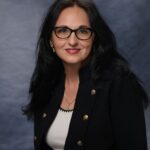QUEST asked Adriana Vasile, Dr. Sanda Dolcos and Dr Florin Dolcos what is a growth mindset and how can it be applied in the classroom.

Source: Canva Original Stickers

Adriana Vasile
Coordinator of ReDesign, a Romanian educational organisation where children can learn at their own pace in a personalized, alternative and safe learning environment. It is a school at the edge of the traditional education system, where their research on neuroscience and learning makes them a credible alternative for authorities. Adriana Vasile presented her work at EUDEC 2023 (European Democratic Education Conference) to show the importance of the link between learning and the functioning of the brain.

Dr. Sanda Dolcos
Co-director of the SCoPE Neuroscience Lab at the Beckman Institute for Advanced Science & Technology at the University of Illinois at Urbana-Champaign working in cognitive and affective neuroscience research, with a special focus on resilience and psychological well-being. Sanda’s main area of interest is emotional regulation and cognitive flexibility.

Dr. Florin Dolcos
Co-director of the SCoPE Neuroscience Lab, focusing more on neuroscience and the neurobiological aspects of emotion-cognition interactions. Together, Sanda and Florin’s research explores the brain mechanisms underlying learning, and how these findings can apply to fields like education, mental health, and on societal level.
QUEST: Could you explain the concept of a growth mindset and how it differs from a fixed mindset?
Adriana Vasile: With the book “Being you” from Anil Seth in mind, a growth mindset starts with being conscious of yourself, knowing who you are and how your neurons, cells and brain works. This awareness allows people to see challenges as opportunities for growth rather than as threats. A fixed mindset, on the other hand, often comes from fear. It is normal to experience fear, but it must be calibrated so it doesn’t stop you from learning.
Dr. Sanda Dolcos: I would add that a fixed mindset is more about the fear of change, where one assumes that we are born with certain abilities that are static, not changeable over time. In contrast, a growth mindset involves believing that skills, intelligence, and abilities can change over time through learning and effort. The awareness that you are able to change things and that learning can literally change your brain is key here, so being aware of these two types of mindsets can already make a difference. Dr. Carol Dweck, professor Psychology at Stanford, came up with the theory of growth mindsets. Neuroscience supports this idea.
Dr. Florin Dolcos: Brain plasticity, which refers to the brain’s ability to form new connections, is at the heart of a growth mindset. This plasticity means we can adapt and change, not just during childhood but throughout our lives. From an educator perspective, I think it’s not necessarily about knowing exactly what’s going on in the brain. As scientists, we are still struggling to know exactly what’s going on in our brains, but being aware of these concepts and different mindsets is important.
QUEST: Adriana, can you tell us how you apply these principles in your school?
Adriana Vasile: Our approach is centered on the individuality of each child. I think it’s crucial for teachers to understand that each student is unique. In traditional classrooms, teachers often treat students as a single group because it’s easier. But when you focus on groups alone, you miss important features of every child.
In our school, we receive children that are extremely frightened, mainly through past negative experiences. We give them the time to relax and just move at their own rhythm, without being forced, and what we see is that this fear diminishes. We prioritize curiosity and exploration. I am convinced that imposing things on kids makes them lose their curiosity, because every individual has its own rhythms and switches that they should be able to respect. We are a small school where this kind of education is possible, the problem is that the education system already has this huge dimension which is difficult to change overnight. But we know things in the education system should change for the best of our children.
QUEST: Sanda and Florin, could you share more about the science behind this? How do emotions and cognitive processes interact?
Dr. Florin Dolcos: Our research has shown that when people experience negative emotions, the amygdala, which processes fear and emotional responses, becomes overactive. At the same time, activity in the prefrontal cortex, which is responsible for focus and cognitive control, decreases. Essentially, the emotional response disrupts the ability to concentrate and learn.
We’ve conducted a series of studies where participants focus on tasks while exposed to emotional distractions. When a negative stimulus appears, their brain activity shifts—the emotional centers light up, while cognitive focus plummets. This interference can linger, especially if the emotional experience is repeated, turning into a permanent red alert state which then more permanently interferes with your ability to stay focused. Also, just the memory of this negative emotion will have the same effect.
Dr. Sanda Dolcos: And what’s important to highlight is that the brain is interconnected. An overactive amygdala affects regions like the prefrontal cortex, reducing its ability to focus and function. If a child is constantly in a state of fear, they literally don’t have the brain capacity to pay attention and it fundamentally impacts their ability to learn. This is why creating safe, supportive environments in schools is so critical, also in the large schools we know today.
Dr. Florin Dolcos: What we also see in our studies is the tremendous plasticity of the brain. With training in emotional regulation strategies, you can literally change the cognitive-emotional circuits in your brain and rewire it so new circuits or new ways of responding are created.
QUEST: How can teachers implement strategies to foster growth mindsets and create these safe learning spaces?
Dr. Florin Dolcos: It starts with awareness. Teachers need to recognize that learning is not about being perfect. It’s about effort and progress. For example, when a student says, “I can’t do this,” a simple change in language can make a huge difference. Adding the word “yet”—as in “You can’t do this, yet”—shifts the perspective to one of growth and possibility.
Adriana Vasile: Teachers also need to model a growth mindset themselves. Having a growth mindset as a teacher also means keeping the focus on every child and learning from what you observe. If you just apply what you were taught without adapting it, you will stay with a fixed mindset.
Dr. Sanda Dolcos: I think the group and collaboration aspect of education is a good thing, but there needs to be room to consider the individuality of children as well. Very important is that the teacher’s mentality should switch to managing the groups in a way that curiosity and learning is encouraged and that it is ok to make mistakes. We learn from our mistakes. If you start this from an early age on, children will find it much easier to adopt this growth mindset. Our brains and abilities are very plastic, so teachers can also adopt a growth mindset if they want to.
Dr. Florin Dolcos: And then there is also the concept of self-efficacy. As Henry Ford said, “Whether you think you can or you think you can’t, you’re right.” Believing that you can change something or do something is the first step. And that is important for children to learn, too.
QUEST: What challenges do you see in applying these ideas to larger, mainstream schools?
Adriana Vasile: Like I said, the biggest challenge is the system itself, which still functions as an industrial revolution model. Mainstream education is designed around efficiency, large classes and fixed schedules. It’s difficult to individualize learning in that kind of environment. Many teachers are afraid to step away from the group-based approach because it’s simply easier to manage.
Dr. Sanda Dolcos: But I believe change is possible. Even in larger schools, teachers can create safe spaces for students to learn and grow. Of course, you need resources and teachers who are open to create mistake-free cultures, encourage curiosity and exploration instead of fostering fear. It starts with a shift in mindset.
QUEST: Finally, what role do parents play in fostering growth mindsets?
Dr. Sanda Dolcos: Parents are incredibly important because they are the first to shape a child’s beliefs. If parents say things like, “You’re not good at basketball” children internalize those fixed beliefs. Instead, parents should encourage effort and exploration—“you’re not good at this, yet”—and create environments where trying new things is valued. If you think about changing things at the societal level, parents are the first ones to think about.
Dr. Florin Dolcos: Yes, and it’s worth noting that parents are often driven by fear. Parents want their children to succeed and to be able to function in society, so they sometimes push too hard without thinking about the impact this can have. Breaking that cycle starts with education. When children come out of school or family settings and enter “the real world”, and they have learned some important skills like adopting a growth mindset, being resilient and regulating their emotions in a safe environment, they have gained the ability to adapt in a changing environment even when they are facing struggles.
QUEST: This has been incredibly insightful. Thank you all for sharing your knowledge and experiences. We look forward to seeing how these ideas can be applied more broadly in education.




